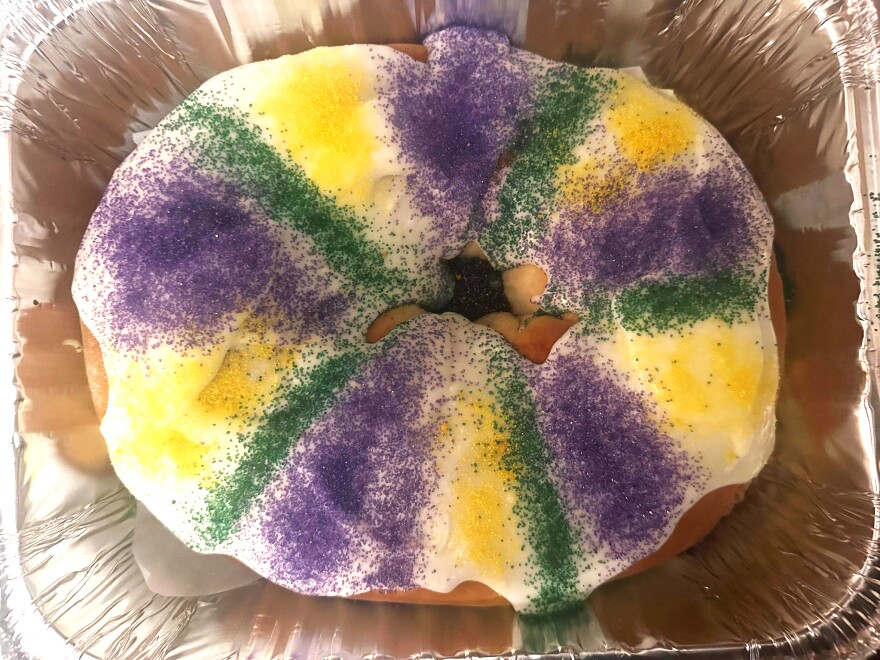Heather Manis first tasted a king cake more than three decades ago, and she still remembers the moment.
“Back in the early '90s, I worked for Kansas City Southern Railway and my first experience with a king cake was in 1991, because we had a station down in New Orleans and they would send them up,” Manis said. “I had no idea what a king cake was.”
These days, Manis is an expert. She's been baking king cakes in her Overland Park kitchen for decades, and her creations are a mainstay for local Mardi Gras krewes — social organizations that organize the parades and balls that fill Carnival season.
Some cultures associate king cakes specifically with Fat Tuesday. But the season of king cakes often begins with the celebration of Epiphany on January 6 — marking the arrival of the three kings in Bethlehem who delivered gifts to the baby Jesus.
Around the Kansas City area, several bakeries mark Mardi Gras by temporarily offering their own king cakes, including McLain's Bakery and Donut King. But the treats are labor intensive, and generally need to be ordered at least two days in advance.

You can find hundreds of different recipes for king cakes online, but traditionally, the confection is a braided wreath of yeasty bread with a sweet filling topped with icing and colored sugar in purple, green, and gold.
The colors are symbolic: Gold represents power, green is associated with faith, and purple stands for justice.
Manis has been baking since she was 12 years old — she would make apple pies with her grandmother, who was born in 1910.
“She gave me this cookbook, the 'Modern Priscilla Cookbook,' with a thousand recipes, and I learned how to make pastry dough and pastry pie crust,” Manis said. “By the time I was about 14 years old, I was making pies from scratch: lemon meringue, coconut cream, and chocolate cream.”
Since then, Manis has become an accomplished baker who posts her creations on Instagram. It didn’t take long before she became obsessed with perfecting the king cake.
“Here's this big cinnamon roll thing with colored sprinkles, and I'm like, OK, sure, I bet I can make that better,” she said.
Manis started researching bakeries in New Orleans to sort out who had the best. She studied the different fillings and the wide range of different king cakes made throughout the South.

What Manis came up with is so rich she calls it a "queen cake." She’s secretive about the recipe, but it starts with a time-consuming, no knead dough that requires hours of time to rise.
“Timing is difficult because a king cake takes several hours to make,” Manis said. “If I have a Saturday, it's easy. I can start the day in the morning, do my chores or errands, come back and check on it.”
Carnival season is a busy time for her showstopping king cakes. There can be a dozen local parties in the month before Lent.
“Some years, I'll bake four cakes for different parties, and I will usually bring a cake to the Mardi Gras marches,” Manis said. “I used to do two on Mardi Gras, one for the morning and one for the evening party.
All king cakes have a tiny plastic baby hidden inside, symbolizing the infant Jesus. According to tradition, the baby is said to bring good luck, and whoever finds it is king or queen for the night of the party.
Manis has some important advice for home bakers: Hide the baby in the cake only after you bake it, because plastic should not be baked in food.
“I promise you won't remember where it is,” Manis said. “By the time you've shoved the little baby up underneath the dough somewhere, put it on your platter, and decorated it, you're not going to remember where it is.”

Another baker who contributes to king cake madness in Kansas City is Lana Malone, who drives up from her home in Wichita.
Originally from New Orleans, Malone’s been baking king cakes for about seven years, selling them for office parties and small gatherings this time of year.
Malone uses her grandmother’s recipe.
“I have eight that are ready for pick up tomorrow,” Malone said. “So we’ve got a quite a bit of baking to do, but it's all a labor of love.”
Malone uses an array of different fillings for her cakes.
“I do a praline cream cheese filling, and then I also do a strawberry one,” she said. “But the classic is just regular brown sugar and cinnamon.”
Malone said her first taste of the festive cake made a strong impression on her.
“It was magical,” Malone remembered. “I was probably four or five years old and they finally let me have a piece of king cake.”

“I vividly remember, getting so upset when it was my birthday time and I couldn't have a king cake for my birthday because it was out of season,” she said.
Malone said she's found that the Mardi Gras tradition does not always translate in the Midwest.
“I think there is a big misconception about Mardi Gras, where it's a lot of, like, you know, debauchery, which there is that, of course,” Malone said. “But a lot of it's family friendly, and it's really just about coming together to have a good time and even be happy to be around the people you love.”





